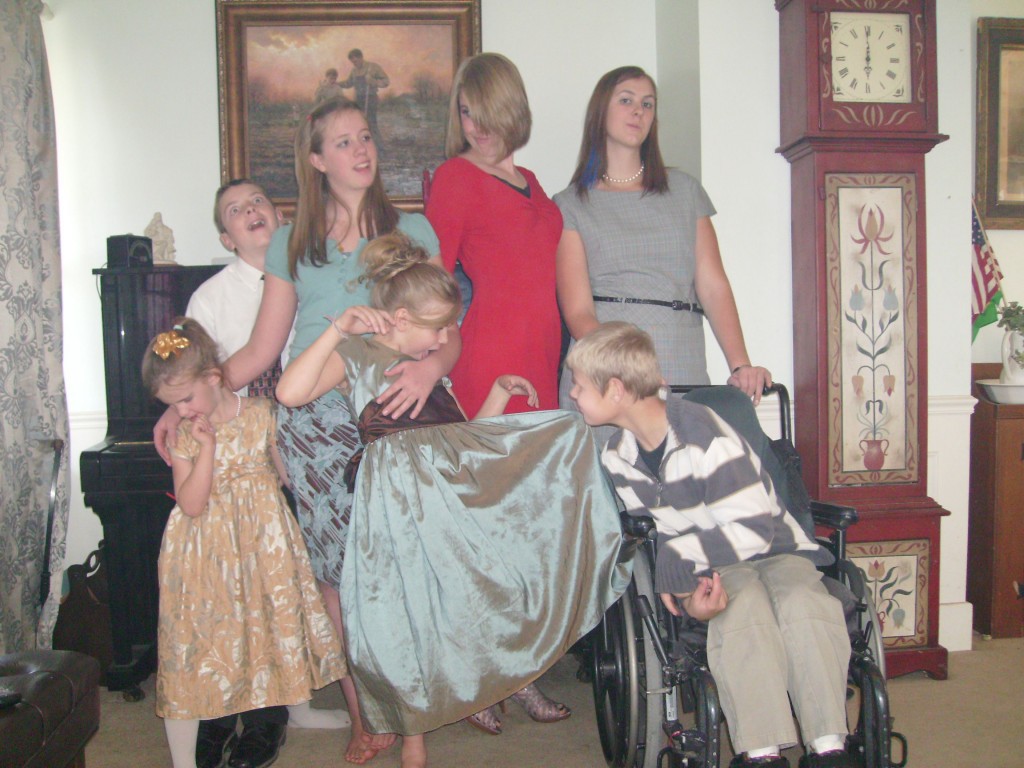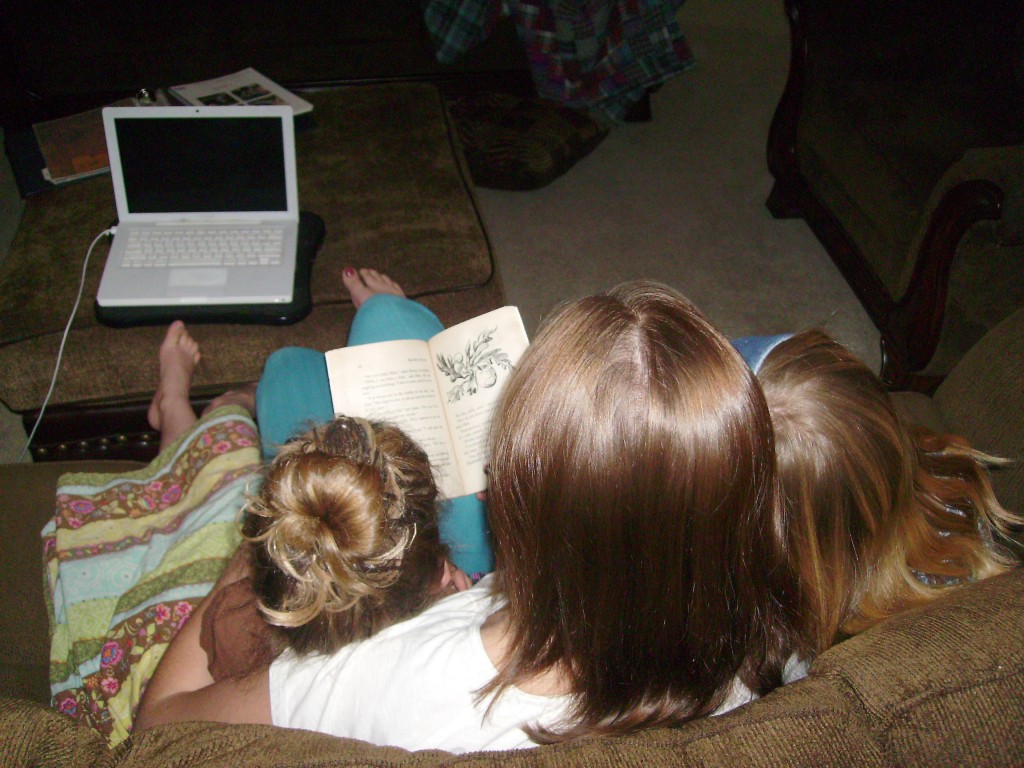With Eliza (15), Ammon (12), America (“Meri”, 8), and Abigail (“Abi”, 6)
Wednesday evening, Family Reading Time…
“Can I ever learn?” I asked, almost ready to cry.
“Of course you can,” said Leon. “You’re smart as the others, I suppose. The sevens and nines of the multiplication table are the stickers, but you ought to do them if other girls can.”
[~Laddie]
I pause my read-aloud, and ask: “Who thinks the nines are hard?” They giggle.
I had already taught them the tricks with nines.
“Which were hardest?” I ask.
Sara (18, in college), Eliza and Ammon vote for Eights. Emma (19, college) says Sixes and Sevens. Meri and Abi have no opinion; they are really more interested in the main character’s pet blue jay. We read on, but a thought stays with me: There has to be a way to demystify Sixes, Sevens, and Eights!
So lying awake early next morning, I challenge myself to find a pattern. Tangents and sidebars spring up as I make mental sticky notes to myself on vocabulary cognates between math-world and real-world, as I ponder what candies would be useful in teaching primes and composites, and…
EUREKA! I found it! But that starts me thinking about a pattern for Sixes, so I turn it over and over like a rubik’s cube, and then…
YES! This one was much easier to find. Of course I hold no illusions. These are probably the simplest of discoveries that curious minds throughout the ages have detected. I’m pretty old to be a budding mathematician, but my career was put on hold when I filled my high school schedule with choir classes once my math requirements were completed. I never made it to Algebra II back then. But I’ve been reading lots of fun math books lately, and my mind is starting to take the hint. (The kids are following suit!)
So it’s 5:07 and I’m reviewing my thoughts, retracing, trying to reiterate them in hopes that they won’t slip away like a pizza dream. I’m able, with some effort, to rewind back to the beginning and replay it. I think I got it all.
At six o’clock, I finally give myself permission to grab my notebook and download the equations and learning activities I’ve been toying with. Downstairs to make me some Mean Green juice while the computer loads my inbox with to-do’s. I start some steel-cut oats to simmer. I can’t wait to share my epiphanies with the kids!
They’re not up for a couple of hours, so I set about some chores; I’m still reorganizing the study when they wander in for their breakfast.
I soon hear a joyful noise from the other room, and go in to find them constructing “geometric solids” and experimenting with the “calculus” of catapult trajectories.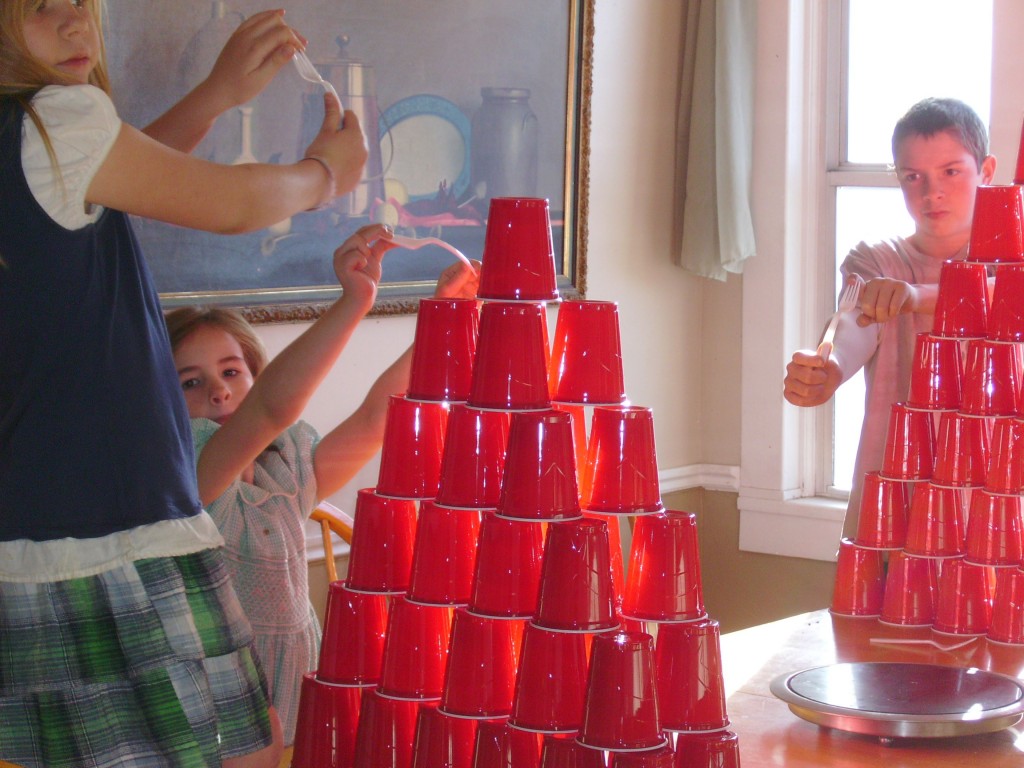
Crash, bang, put it all away, and it’s time now to start our “kidschool.” We meet in the great room around a table. There are all manner of supplies, resources and of books within a few steps. A prayer and pledge help get us in harmony, then we start with me sharing…whatever I’m excited about.
I call it “Rachel’s ‘Mine'” – a double entendre that represents nuggets from my personal study that are fun or inspiring for me. I feel strongly that the most important thing I teach is a passion for self-education; if they master this, the whole world is theirs.
In past days Rachel’s “Mine” has ranged from hearing the peasant wedding, the horns on the hunt and the raging rapids in Smetana’s “The Moldau” to deconstructing Tennyson’s “The Eagle” as the riddle that it is – admiring the images, the word choice and the sense of wonder it evokes.
Today, though, I’m eager to find out if my wee-hour brainstorming will translate. Will the kids think it’s as cool as I do?
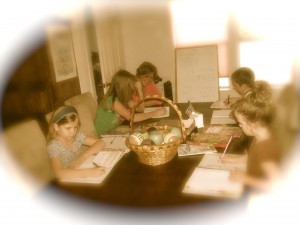 Eliza has inherited my fascination with numbers, and she’s all in. Ammon is game and follows right along.
Eliza has inherited my fascination with numbers, and she’s all in. Ammon is game and follows right along.
Meri and Abi may listen in and out as they want, and have little projects at the table to keep them busy and happy. Eliza and Ammon literally laugh out loud as I show them what I found. We play with math on the white board for a while, move on to some other things, and after an hour or so I’m feeling pretty good.
Then we split up. Ammon plays Memory with the girls while I read A History of US and Eliza works on algebra – all around the table. Then they go do their other projects.
Eliza’s in Scholar Phase, and Ammon’s in Transition to Scholar, meaning that they have contracts that define their study schedule, privileges and responsibilities as young adults in the home. They are each reading a novel from the TJEd Teen 100 Book List, and together they spend some time on my computer reviewing the resources on This Week in History.
Meri is in Love of Learning Phase; Abi is in Core Phase. Knowing about the Phases of Learning helps me ignore pressures to conform so I can focus on what’s most important for each of my kids.
While reading with me, Meri asks, “Mom, why can’t I go to public school?” She and Abi look on expectantly for me to say something wise.
I mutter a little prayer under my breath. I want them to understand why we do what we do, but I don’t want them to assume that other parents are not making the right choices for their own kids, or that the amazing and dedicated teachers in the public schools are not worthy of our profound respect and gratitude. I attempt an answer and Meri appreciates the effort, but I can see that this conversation is not over.
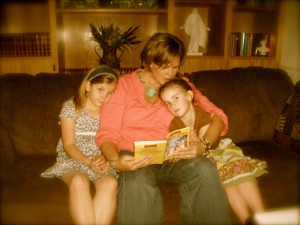 We return to reading together. Lo and behold, the book is a godsend. The Boxcar Children are going on an ocean voyage, and their amazing teachers have prepared for each a notebook with personalized studies based on their journey and the kids’ individual needs.
We return to reading together. Lo and behold, the book is a godsend. The Boxcar Children are going on an ocean voyage, and their amazing teachers have prepared for each a notebook with personalized studies based on their journey and the kids’ individual needs.
I point out how brilliant and thoughtful these teachers were in their selections (navigation by the stars, radio communication via the ship’s system, meteorology, marine biology, etc.).
I explain that this is what Mommy and Daddy are doing for her and each of her siblings.
I tell her that teachers in today’s classrooms have limitations on how they share their deepest feelings, what books they can use, and the time they spend on each child.
In our home, we do not answer to someone that doesn’t know Meri’s interests, gifts, or personal mission. There will be no cookie-cutter curriculum for her! We select resources, projects and applications designed to help her achieve excellence in both character and competence, and prepare her to do what she was born to do. We call this Leadership Education, or “TJEd.”
Meri beams with gratitude and individual worth. And this time, because of the example in a story she’s loving, the words hit home, and she really gets it. I am thankful, not for the first time, that the classics do the heavy lifting for me in teaching and inspiring my kids. We read Hirsch and Fred.
Towards evening, Dad gathers the family in the great room; we read scriptures and then from our current family novel, Laddie. This is the fourth time we have returned to this favorite, and the older kids are as thrilled as we are to share it with their sibs.
After dinner, Oliver and I spend some time debriefing the day, talking business, arguing politics and watching football. Pretty soon I’m tuckered out and head to my room. But Dad’s a night owl, and he’ll get a crack at the kids while I’m settling down to review the day before bed.
He leaves a note for me to find in the morning:
- He had Ammon teach the little girls about Abe Lincoln and the Civil War (with details filled in by Dad). They talked about honesty, persistence, and slavery. Meri said it reminded her of the book Dad had recently read to her, Johnny Bunko, which teaches, “Persistence Trumps Talent”. They reviewed and discussed the other five lessons from the book.
- He had Ammon tell Meri and Abi the story of “A Winter’s Tale,” then put the girls to bed.
- Dad found an article on Finnish Education Reform; he reviewed and discussed it with Eliza.
- He worked with Ammon on Scouts for an hour.
As I take stock, here are…
The Things I Meant To Do, But Didn’t Get To, Today:
- Piano lessons with Eliza and Meri
- Make a clock face for use as a number line, multiplication manipulative, etc. Maybe tomorrow?
- Help Ammon write his paper for Key of Liberty class, due next week
- Review/update Eliza’s Scholar Contract and make sure we’re in sync on her goals and plans
- Take back the library books
Tomorrow the neighborhood co-op will be at my house. We’ll learn some ASL, some anatomy, and I’ll test my math magic with the moms. I’m having some epiphanies on patterns within the set of numbers that are perfect squares…
Want more examples of how homeschool looks for a veteran family? Check these out:
- Good Days and Good Days
- Simplicity and Elegance – almost as good as a nap
- How do you organize a large family for homeschool?
- Large Family, Part 2
- A Thomas Jefferson Education in our Home
Are you passionate about self-education? How do you share your passion with your kids?
Rachel DeMille is the wife of (and collaborator with) Oliver DeMille, and together they are the founders of Leadership Education [TJEd]. They have 8 children.

